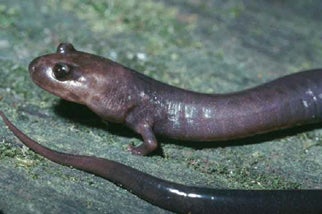SCIENTIFIC NAME:
Phaeognathus hubrichti (Highton)
OTHER NAMES:
None.
STATUS:
Threatened, but may be locally common under optimal conditions. Entire global distribution confined to six Alabama counties in Buhrstone/Lime Hills ("Red Hills"). Eliminated from many formerly inhabited sites by habitat disturbance. Designated the official state amphibian by the Alabama Legislature. Listed as threatened by the U.S. Fish and Wildlife Service. HIGHEST CONSERVATION CONCERN.
DESCRIPTION:
A large (max. total length approx. 25.5 cm [approx. 10 in.]) terrestrial salamander with a prehensile tail almost as long (47 percent of total length) as body. Body and tail uniformly dark brown to dark gray. Body elongate, with 20 to 22 costal grooves. Front (four toes) and hind legs (five toes) relatively short and stout. More than 12 intercostal folds between adpressed limbs.
DISTRIBUTION:
Only terrestrial vertebrate confined to Alabama and irregularly distributed within a narrow belt of two geological formations (Tallahatta and Hatchetigbee) in parts of six counties (Crenshaw, Butler, Covington, Conecuh, Monroe, and Wilcox) in the Red Hills (Schwaner and Mount 1970, Mount 1975).
HABITAT:
Fossorial, on steep slopes (especially north-facing) of ravines and bluffs dominated by hardwood trees (magnolias, American beech, tuliptree, oaks, hickories, etc.). Older growth timber preferred. Outcroppings or layers of siltstone or claystone near the surface, with which the burrows are typically associated, may be required. Weathering of these materials causes deep cracks and fissures that are inhabited by the salamander and that are believed to provide appropriate levels of burrow humidity during droughty periods. Complete removal of forest canopy in most cases results in extirpation of a resident population. In occupied habitats, loamy, friable topsoils are usually present, and ground-dwelling arthropods abundant.
LIFE HISTORY AND ECOLOGY:
In undisturbed habitat, spends virtually all of its time in its burrow system and about 12 hours continuously at the mouth of the burrow from dusk until dawn, apparently to feed on forest-floor arthropods (Schwaner and Mount 1970, Jordan 1975, Bakkegard 2002). The time spent at the burrow mouth does not vary year-round, except that fewer individuals are seen in winter. Eggs laid in late June or early July and hatch in late August. One clutch of six eggs found 30 centimeters (approx. 12 inches) deep in a steep bank were suspended from the ceiling of a fissure in the clay but the female was 28 centimeters (11 inches) deeper and not in attendance. Examination of reproductive tracts suggests clutches of four to eight eggs are laid. Hatchlings are terrestrial, but possess gills for about 10 days (Means 2003a). The low proportion of juveniles encountered has led one investigator to conclude that recruitment is low (Means 2003a). Longevity in wild unknown, but one individual at the Cincinnati Zoo is more than 25 years old (W. Card, pers. comm., 2003). While some burrows persist for years, natural slope erosion at one study site resulted in an average burrow half-life of 90 days (Gunsburger and Guyer 2000). Population densities vary according to habitat conditions, and burrows are typically spatially clumped rather than evenly distributed throughout seemingly suitable habitat. Individuals display strong burrow fidelity over time, and the occupancy rate approaches one salamander per burrow (Carroll et al. 2000).
BASIS FOR STATUS CLASSIFICATION:
Amount of suitable habitat remaining for the species within its small geographic distribution was last estimated to be 22,200 hectares (54,900 acres) (French and Mount 1978). About 1,245 hectares (3,075 acres) of that amount had been affected detrimentally by forestry operations during the previous decade, and at least 1,485 hectares (3,670 acres) not included in the 22,200 hectares had supported populations that were eliminated prior to January 1976. A 1988 reassessment (Dodd 1991) of 92 sites first documented in 1976 (French and Mount 1978) revealed that habitat conditions had declined at 20 percent of the sites, all from selective or clearcutting, and that conditions had improved (after logging) at another 20 percent of sites. Only 61 hectares (150 acres), or 0.2 percent of the estimated habitat, are publicly owned. Of the remainder, more than 40 percent is corporately owned or managed. Voluntary 30-year Habitat Conservation Plans (HCPs) have been developed with the U.S. Fish and Wildlife Service to permit limited timber harvest while providing protection of optimal and moderate habitats. Four industrial ownerships and one nonindustrial private ownership, totaling approximately 4,450 hectares (11,000 acres), are presently enrolled in HCPs, but similar commitments from other landowners have not been secured. Unique in being the only member of its genus, the longest member of its subfamily, and, possibly, the only amphibian species endemic to Alabama. Priority designation warranted in view of the aforementioned, the animal’s extreme habitat specificity, its apparent low reproductive rate, and its low vagility. Designated the state amphibian by the Alabama Legislature. Listed as threatened by the U.S. Fish and Wildlife Service in 1976.
Author: Mark A. Bailey and D. Bruce Means






